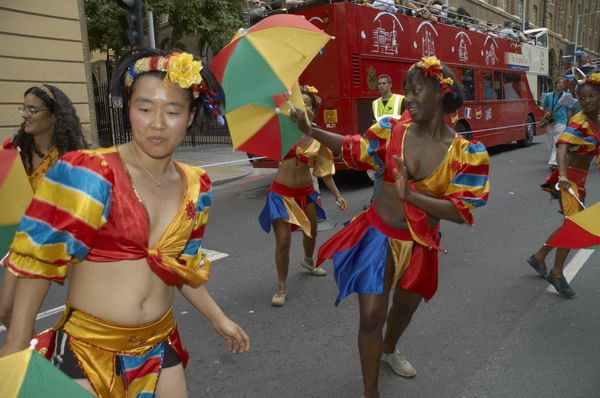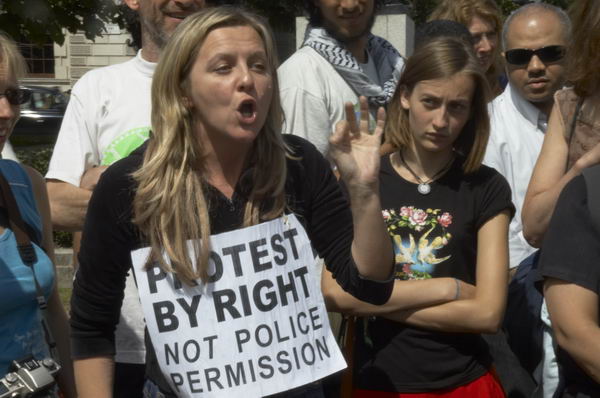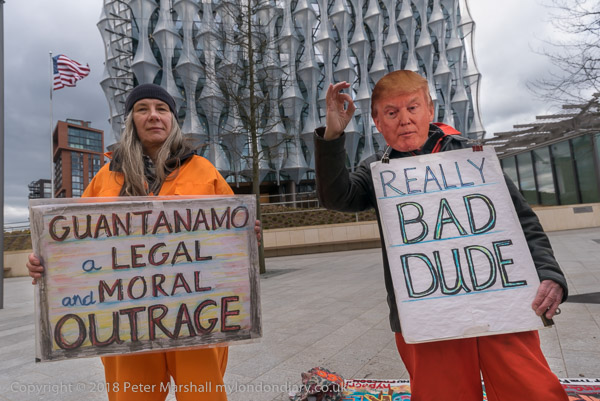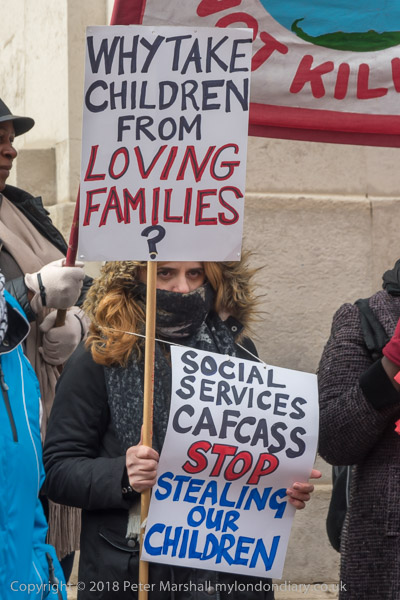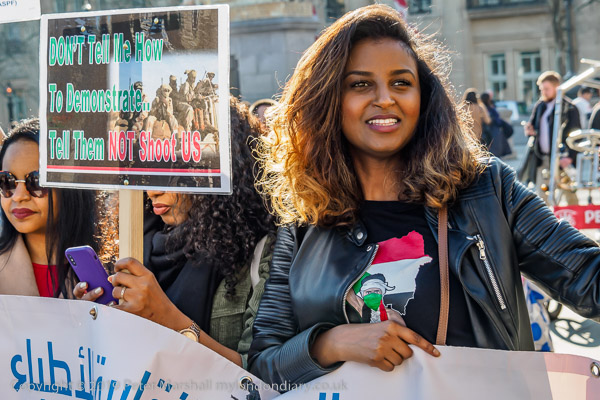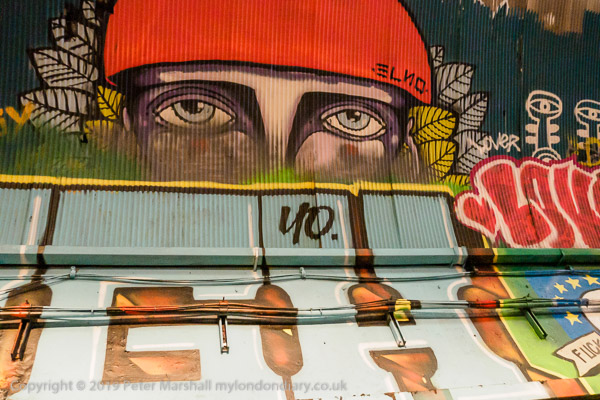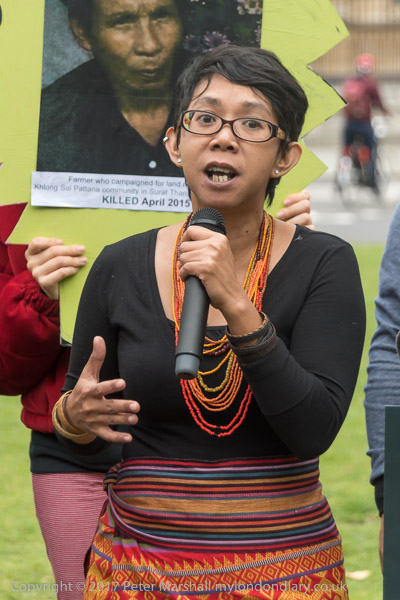Slavery, Climate, Stolen Goods & Santas: on Saturday 8th December 2018 I began with a march against African migrants being enslaved in Libya, photographed Buddhists meditating against climate change, went to the British Museum for a call to them to return indigenous Australian cultural objects and finally met hundreds of people in Santa costumes in Covent Garden.
Protest Slavery in Libya

There had been large protests a year earlier about slave auctions in Libya where many African migrants trying to reach Europe are captured by bandits, terrorists and jihadists – often funded by the EU and other outside countries – and sold as slaves.
The replacement of Gadaffi and his replacement by Western-backed puppets was a part of a continuing neo-colonialist attempt to control Africa’s natural resources which has led to the instability and mass migration from African countries to the south. Libya had begun a process of de-Africanisation and elimination of Black Libyans and the slave auctions are a simple extension of this policy.

Like many other issues, this had simply dropped out of the news despite the UK and other countries failing to take any action, perhaps why this protest was only by a small group. They met for a short rally outside the EU offices Europe House as the deals and actions of the EU to prevent migrants reaching Europe means many more of them are detained in Libya.

They then marched to protest outside the Foreign & Commonwealth Office, saying the UK had failed to do anything to help because the victims were African, then stopped briefly at the gates to Downing Street before marching on to the Libyan Embassy. I left them at Trafalgar Square
Dharma meditation for climate – Trafalgar Square

A small group from the Dharma Action Network meditated in Trafalgar Square as a call for people to take action, suggesting people move their money out of banks which invest in fossil fuels, get informed by reading the IPCC report on global warming and join them and other groups including Friends of the Earth, Greenpeace and take direct action with Extinction Rebellion.
British Museum Stolen Goods Tour

I joined Indigenous Australian campaigner Rodney Kelly and others on the tour organised by BP or not BP? in the Kings Library of the British Museum in front of the glass case displaying the Gweagal shield stolen from his ancestor by Captain Cook at Botany Bay. Kelly is a 6th generation direct descendant of Cooman, whose Gweagal shield was taken when Captain Cook’s men on first landing in Australia opened fire with muskets, and the shield has a small hole caused by a musket round.

BP or not BP? activists came dressed as burglars in striped jumpers and black masks with sacks for swag.

Another, dressed as a ‘BP Executive’ explained how their sponsorship of art including exhibitions at the British Museum helps to clean up their reputation, tarnished by oil spills, the exploitation of oil fields around the globe with its associated environmental damage, the sale of climate change producing fossil fuels and more. It all looks much better with the nice glossy image of exhibitions such as those at the museum.

They then introduce Kelly who began (and ended) his talk by playing his didgeridoo, and then talked about how the British Museum had dismissed his earlier attempts to return the shield and other items, and had refused to take seriously the oral tradition of his people as it could not be confirmed by written records.

After retelling the story of how it was stolen and how the museum came to acquire it, he told the crowd now packing the room how the shield which few people stop to look at in the museum would reinvigorate the traditions of his people back in Australia and would be both the centrepiece of a museum of indigenous Australia and revive a great interest in traditional crafts.

The crowd then moved on to sit on the floor in front of the then current BP-sponsored Assyrian exhibition, where an Iraqi woman spoke, telling us that objects looted from Iraq during the invasion in 2003 and bought by the British Museum were on show which clearly should be returned to Iraq. Looting of cultural artifacts was considered respectable and normal back in the days of the British Empire (or at least by the British) but is no longer acceptable.

We moved on to a room devoted to objects taken from Polynesia where we heard about looted objects from the region and a statement from the Rapa Nui Pioneers on Easter Island calling for the return of their stolen Moai Head.

It was now time to visit the huge room containing the Parthenon Marbles, which Elgin claimed to have taken them with the permission of the Ottoman Empire, then rulers of Greece, but this now seems unlikely – and the marbles in any case surely belonged to the Greeks rather than thier occupiers.
Here one of the BP or Not BP? burglars, Danny Chivers, revealed himself to be part-Greek and talked about a recent visit to the Acropolis Museum, close to the Parthenon, where a room containing the marbles that Elgin left in Athens are displayed, complete with gaps in the appropriate places for those currently on display in the British Museum.

It seems clear that they should be returned to Athens, and it would now be possible – if expensive – to make a set of visually identical replicas to continue to display here. Perhaps in return for sending them back, the BM could receive replicas of those that remained in Athens – and so both cities could have a full set.
More at British Museum Stolen Goods Tour.
London flooded with Santas – Covent Garden

Finally I met Santacon in Covent Garden, with crowds of people dressed in Santa costumes, together with the odd elf and reindeer making their way to Trafalgar Square, spreading glad tidings as darkness fell, some following hand-pulled sound systems and dancing on the streets, though many groups were diverted into pubs and food shops on the way. This year the charity event was supporting ‘Christmas for Kids’ as well as having a great deal of fun.
Many, many more pictures at London flooded with Santas.
Flickr – Facebook – My London Diary – Hull Photos – Lea Valley – Paris
London’s Industrial Heritage – London Photos
All photographs on this page are copyright © Peter Marshall.
Contact me to buy prints or licence to reproduce.




